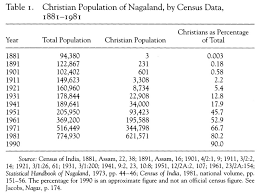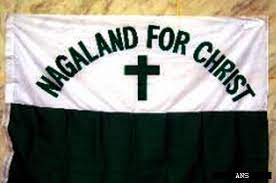In ancient times, it is said that Nagas came from China and settled in the hills of Nagaland. The name Naga is derived from Burmese Naka (pierced ear) and has no connection with Naga Sadhus or Naga (snakes) whatsoever.
During the 18th century, Ahoms rule in Assam began to wane due to internal strife as well as external attacks. In 1790, Ahom King Gaurinath Singh asked the British for assistance in resolving political conflicts. Though the British dispatched Captain Welsh to Ahom territory, the British maintained a strict policy of non-interference in Ahoms’ internal affairs. Sensing the opportunity, the Burmese attacked and took control of the Ahom kingdom. British then had to jump in to protect their territory, leading to the first Anglo-Burman war, lasting from 1824 to 1826. Following their victory, the British signed the ‘Treaty of Yandabo,’ ending Burma’s dominance and changing the course of history for the people of the North East. The Raja of Manipur and Ahom of upper Assam were restored initially, only to be gradually annexed by the British Empire in India later. Almost the whole Northeast came under British administration by the 1850s.
In the 1820s, Company officials discovered tea, and Assam was found to be a perfect place for world-class tea. Huge numbers of Britishers started to settle in the region to manufacture and trade, influencing the politics in the area. An early key player in the business was Charles Alexander Bruce, who became the Superintendent of Tea Culture in Assam. His tea gardens were regularly raided by the neighboring tribes; chiefly by Nagas. He was, however, unconcerned that his plantations encroached on their ancestral lands. He started persuading political authorities to end the menace and as a novel idea, asked missionaries to be sent to “civilize the savage tribes”. Meanwhile, coal was also discovered in the Naga foothills, the exploitation of which was made difficult by political instability. Capitalist investments and their protection would repeatedly emerge as a central motivation for Christian evangelization.
In 1835, Commissioner Captain Francis Jenkins requested the American Baptist Mission (ABM) to send missionaries to the region. The Board gladly seized the opportunity to expand its mission field. Two ABM missionaries, Nathan Brown and OT Cutter, were already stationed in Burma and were now relocated to Assam. The ABM was ambitious and intended to evangelise the highlands between Burma and India, which, they reasoned, would open a gateway to the ultimate target: China.
Later, Missionaries from various countries like England, Wales, the United States, Australia, New Zealand, Germany and Italy made a beeline after covering half the globe to harvest the souls of the natives. Churches of every hue, Roman Catholic, Baptist, Presbyterian, Lutheran, and Anglican, set up their shop to show the natives only one true God.
Excited by the probability of converting the whole population, one Miles Bronson of New York, accompanied by his wife and another missionary family, Jacob Thomas and Sarah Maria Willsey, arrived at Calcutta in 1837. On the way to Assam, Bronson caught jungle fever, and Jacob Thomas was killed by the abrupt fall of a tree. Thus began the first of many misfortunes that were to befall the Bronsons.
After deciding on a mission field, Bronson set out on his first survey tour of the Naga Hills, home to the Noctes, in 1839. A three-day walk brought him to the gates of Namsang village, some of whose residents he had met in Jaipur’s tea gardens. The Naga Chief and his entourage suspected him of being a spy, a ‘Company Man,’ and thus a potential threat. It took Reverend Bronson several days to persuade the villagers that this was not the case and that his only goal was to help them. Soon, with the help of interpreters, he translated textbooks into the Naga language. It proved to be the game-changer and slowly, his followers increased and began to be converted to Christianity. He opened a school wherein ten students were studying within three months.
However, after a few years, students as well as converts didn’t increase substantially, forcing Bronson to abandon the programme. The British government, at least officially, kept its hands off the matter. There was a lull during the next three decades, but things were to change substantially.
In the aftermath of the first war of independence in 1857, the British became the masters of the country and now made up their minds to eschew the non-interference policy towards the natives’ religions and wholesomely invite missionaries to convert the pagans, hoping that new Christians will be loyal to fellow British Christians. Reverend Edward Winter Clark, an Ivy League-educated missionary, arrived in Sibsagar (in Assam) on 30 March 1869, as by then, the ABM base had shifted to Sibsagar.
Clark first came in contact with a group of Ao Nagas, who habitually came down to the plains to trade salt and other things in 1869. A year after, Gendhela Barua (After conversion, Godhula Rufus Brown), an Assamese evangelist teaching in Sibsagar Mission School, introduced Clark to a recently converted Ao Naga man named Supongmeren. In the same year, Godhula, along with Supongmeren, went up to the latter’s village and started the conversion programmes in full swing. As a time-tested practice, they identified the fault lines in tribal societies and began to exploit them. The weaker among them were the first ones to convert. These neo-converts became the agents of Christianity and started brainwashing their friends and families to convert, sometimes through money, sometimes through threats. It was like pyramidical marketing companies wherein a new member immediately after joining solicits others to join and make profits. As for the spread of Christianity, Frederick Sheldon Downs, a Christian historian, similarly observed:
The beginnings of Christianity among numbers of new tribes were almost always due to the work of members of other tribes rather than of foreign missionaries. The Assamese were the first evangelists among the Ao Nagas and played an important role in the establishment of Christianity among the Angamis; Ao and Angami evangelists in their turn preaching to members of neighboring tribes with whom they had previously fought.
In 1897, the first Ao Baptist Church Association met in Molungyimsen. The ‘harvesting of souls’ was slow but steady. The then prevailing Naga ways, such as headhunting, offering sacrifices to deities, warfare, dancing, attire, drinking of rice beer, and so on, were discouraged, and they were made to be ashamed of their culture. A few of the tribes followed matrilineal system but were told to switch over to patrilineal system by missionaries. They were also asked to shun their traditional attire and put on coats and pants and learn English.
Bronson’s missionary progress was hampered by a lack of reinforcements and an immediate replacement after his departure. The eruption of the American civil war in the 1860s also hindered the funds flow. All of this suggests that the early history of Christianity among the Nagas is intertwined with capitalist interests enabled by colonialism. If tea and coalbed exploration had not occurred in their foothills, the Nagas might not have become Christians as early as the 19th century.
Even then, after so much effort, conversion made little inroads. In 1911, the Christian population in Nagaland was only 2%, and in 1931, only 13%. However, after that, Christianity took wings as by 1951, it was huge at 46% and now 88%. What happened in the 1930s and 1940s? The British were in decline, and the two World Wars broke their back. Nehru had occupied the center stage by then and played his own dubious part when he proclaimed that tribes should be left on their own. Helping him in his cause was Verrier Elwin, who embraced Hinduism, yet threw tribals into the fold of Christianity. In this vacuum, missionaries had virtually virgin fields, where seeds were sown long back. From here, Christianity didn’t look back.

Neighboring Assam was in stark contrast to Nagaland as far as conversion was concerned. It was not that missionaries did not make any effort here. In Assam, the hold of Hinduism was much stronger, as Majuli, the biggest river island on the Brahmaputra, has a big Vaishnava seat. Assam was not rocked by the Muslim invasions that much, and they didn’t find any need for conversion.
Islam forces its converts to look to Mecca, while its elder cousin Christianity expects them to look to the Vatican. Both sets of followers have a singular identity of religion, where nationality loses its meaning. The same happened in Nagaland. As soon as they were in the majority, the rumblings of their own nation started as they did not want to be under Hindus. However, every Christian in the Northeast avails the benefits of being an ST.
Gandhi, secular to the core and thus to the detriment of India that is Bharat, agreed to let them choose their own nation. Nehru, quite uncharacteristically, didn’t let that happen and pushed them to join India. However, it was not love for India which forced his cards, but the insult heaped on him by Nagas when he went to Kohima to sort out the issue. Indian army then launched a military operation in 1954 to kill the insurgency, which, in turn, expedited the conversions as hate towards India grew by leaps and bounds.
I visited Kohima in 2004 in a relatively peaceful era, but the visit was disappointing, to say the least. The city looked like a European one where everyone was dressed in Western clothes, with not a single soul in traditional attire. Except for the signboards of a few banks wherein ‘India’ is written, you may not identify it as an Indian city. The town was dotted with Churches of European architecture and of different denominations, where I was told members of other churches couldn’t enter. A similar situation is for mosques all over India. Shias can’t enter Sunnis’ mosques and vice versa. And lo behold, Hindus are vilified for casteism.
Nagas were looking at us as if they had seen aliens, though they may also claim that they feel the same way whenever they are in mainland India. The hotel manager asked us not to roam around the city and return as soon as possible the following day as locals intensely dislike ‘Indians’.
I had one more weird experience with Nagas. While attending a marriage of a Naga colleague in a Delhi Church, an American pastor started preaching about one true God and indirectly asked us to convert. It was an entirely Christian wedding with not a single native ritual.
All in all, there is a strong undercurrent of Anti-India and Anti-Hindu feeling in Nagaland, which runs even today and attacks on the Indian army keep happening sporadically. American Baptist Mission routinely writes Anti-India articles and carries out subversion activities on the soil of Nagaland. Today almost all their ancestral religious rituals, traditions and practices have disappeared among all the tribes who have converted, with many even ashamed of their past. The name Nagaland is symptomatic of such a colonial mindset. Many of their languages have vanished with few surviving ones being written in Roman script. In contrast, the people of Arunachal Pradesh have adopted the Devanagari script.
The men who once sang hearty war songs nowadays sing ‘Praise the Lord!’ instead.
——-
Written by Amit Agarwal, author of the bestseller on Indian history titled “Swift Horses Sharp Swords” and “A Never-Ending Conflict”. You may buy the books at the following link:
https://www.amazon.in/gp/product/B08KH3R4MN https://www.amazon.in/dp/B0B6J5PKPR
https://www.amazon.in/dp/9355788266 (Hindi)
Twitter handle @amit1119, Instagram/ Facebook – amitagarwalauthor
Source: Lark Murrey, The Birth of Christianity in Nagaland
Barpujari, H. K. The American Missionaries and North-East India 1836-1900 AD.
![]()
- How Hindu rituals spawned numerous advancements in science, maths and other arts - March 13, 2024
- Naga Sadhus and their fighting skills - February 20, 2024
- Lessons for India from the Israel-Palestine conflict - October 12, 2023

